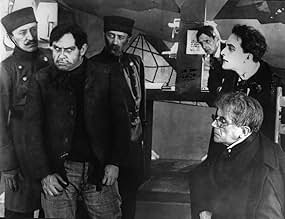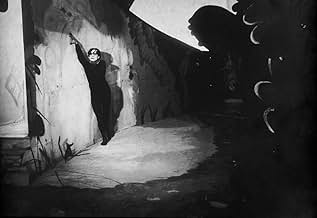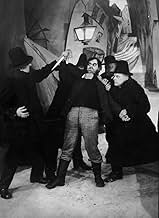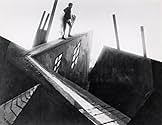IMDb रेटिंग
8.0/10
74 हज़ार
आपकी रेटिंग
कृत्रिम निद्रावस्था में लानेवाला डॉ कैलिगरी एक सोमनामबुलिस्ट, सीज़र का उपयोग करता है।कृत्रिम निद्रावस्था में लानेवाला डॉ कैलिगरी एक सोमनामबुलिस्ट, सीज़र का उपयोग करता है।कृत्रिम निद्रावस्था में लानेवाला डॉ कैलिगरी एक सोमनामबुलिस्ट, सीज़र का उपयोग करता है।
- पुरस्कार
- 2 जीत और कुल 1 नामांकन
Friedrich Feher
- Franzis
- (as Friedrich Fehér)
Hans Heinrich von Twardowski
- Alan
- (as Hans Heinz v. Twardowski)
Rudolf Lettinger
- Dr. Olsen
- (as Rudolph Lettinger)
Rudolf Klein-Rogge
- Ein Verbrecher
- (बिना क्रेडिट के)
- …
Hans Lanser-Ludolff
- Ein Alter Mann
- (बिना क्रेडिट के)
- …
Henri Peters-Arnolds
- Ein Junger Arzt
- (बिना क्रेडिट के)
- …
Ludwig Rex
- Ein Mörder
- (बिना क्रेडिट के)
- …
Elsa Wagner
- Die Wirtin
- (बिना क्रेडिट के)
- …
फ़ीचर्ड समीक्षाएं
With a story as twisted, buckled and demented as the scenery and set design, and a tortured score to boot, was the lunatic in charge of the asylum? Must have been a moment to remember coming across this cinematic marvel back in 1920. I wonder how many of today's pieces of cinema will stand the test of 100 years, albeit with a lot more competition.
The original message of this film is fairly pedestrian (an outcry against the weak authority in Germany at the time), although the political intrigue surrounding the production led to a fascinating framing story which re-established "the authorities," and in turn made the UFA happy enough to distribute the film. This suggests that in its own time the political message of the film was fairly powerful, but compared to the work done in such films as The Golem, Nosferatu, and Metropolis it is not so far-reaching.
What sets this film apart from its contemporaries is its absolute commitment to the expressionist movement. Mutated sets, heavy dark/light makeup, light and shadow, and a Gothic storyline are classic expressionism. The photography is beautiful and so crisp that it creates an eerie sense that this hellish scene is actually the real world, and that our everyday lives are the delusional Technicolor dream of a madman.
While there are many better movies made in this period, I feel that this one is the pinnacle of the imagery that is characteristic of the expressionist art form. It is an absolute must-see for anyone who is interested in the Expressionist movement.
What sets this film apart from its contemporaries is its absolute commitment to the expressionist movement. Mutated sets, heavy dark/light makeup, light and shadow, and a Gothic storyline are classic expressionism. The photography is beautiful and so crisp that it creates an eerie sense that this hellish scene is actually the real world, and that our everyday lives are the delusional Technicolor dream of a madman.
While there are many better movies made in this period, I feel that this one is the pinnacle of the imagery that is characteristic of the expressionist art form. It is an absolute must-see for anyone who is interested in the Expressionist movement.
This movie was shot between 1919 and 1920, a few decades since the motion picture camera was invented, and the Lumière brothers were in the middle of their experiments with it. At the time, cinema was being considered as a new way of making art, and yo make art you had to marry with a serie of ideas: ideology, aesthetics, cosmogony, etc. In these terms, this movie belongs to the German expressionism, which is reflected in the entire setup: from characters make up to the background of the set.
Having an average murder-mystery plot, the movie can be defined as a painting with some action occurring in it. The whole scenario was displayed following the same criteria as in expressionist painting: all diagonal and curve lines, evading the straightness and the cardinal orientation of things, wicked perspectives and proportions. Even the more minimum detail was carefully considered to fulfill the aesthetics needs. The result couldn't have been better, considering that the only visual trick they could do was to shrink/enlarge the camera's diafragma. Think that this was before the concept of travelling was even developed.
Concerning the plot, yet it's true that it isn't really the great thing and that many people now a days find it boring, I got to enjoy it, further than its aesthetical function (I even got to laugh in a couple of scenes), and I highly recommend it, as a good old piece of art from which many of today's film makers may take some good lessons on how to approach movies. I'm sure that if they got understand that, then there would be much lesser crappy movies than there are now a days.
Having an average murder-mystery plot, the movie can be defined as a painting with some action occurring in it. The whole scenario was displayed following the same criteria as in expressionist painting: all diagonal and curve lines, evading the straightness and the cardinal orientation of things, wicked perspectives and proportions. Even the more minimum detail was carefully considered to fulfill the aesthetics needs. The result couldn't have been better, considering that the only visual trick they could do was to shrink/enlarge the camera's diafragma. Think that this was before the concept of travelling was even developed.
Concerning the plot, yet it's true that it isn't really the great thing and that many people now a days find it boring, I got to enjoy it, further than its aesthetical function (I even got to laugh in a couple of scenes), and I highly recommend it, as a good old piece of art from which many of today's film makers may take some good lessons on how to approach movies. I'm sure that if they got understand that, then there would be much lesser crappy movies than there are now a days.
10wmackey
Dr. Caligari presents the viewer with a frightening vision of the world through the lens of German Expressionism.
I cannot recommend this film highly enough. It's truly fascinating. And, it really (really) is an art film, since it purposefully and strikingly exhibits the new art of the German inter-war milieu. So, be prepared for an other-worldly excursion into the "total work of art," or Gesamtkunstwerk, of this monumental and influential film.
This film is best seen at night, alone, and with the modern soundtrack which is available on the fully restored version. If the DVD you're watching does not have (a) choice of two soundtracks (traditional music and much-scarier modern track), (b) tinted inter-titles set in a surrealistic (actually expressionistic) font, and (3) is fairly high quality, then send it back and get the restored version. The quality and completeness of silent films are a major factor in experiencing the art form as it was meant to be experienced. The modern sound track in Dr. Caligari makes the film much more accessible for modern audiences (the eerie effects in the modern track heighten the feel of the film for the modern viewer) - try both tracks, you'll see.
It's surprising how frightening and impactful this film can be. You will have dreams about it, I promise. These between-the-wars German films are riddled with creepy foreshadowing for us in the present, who know what was about to happen in Germany.
Anyway, I think the film is best viewed with NO NOTICE. You don't really want to know the plot (the meaning of the end of the film can be interpreted in radically different ways - keep that in mind when it happens). Only one note - artistically the German Expressionist movement is worth reading about after you see the film - you'll notice the theme of "death and the maiden" woven into this artwork. Also, this film is the direct ancestor of films like "Nightmare Before Christmas" and a lot more - you'll recognize the Expressionist look in many presentations in television and film.
WARNING - I would NOT show this film to children. It's very subtly and psychologically undermining - you'll be thinking and freaking about this thing for months to come - such a thing shouldn't be experienced by children - it's an adult, art film (no, not that kind) made for adults.
I cannot recommend this film highly enough. It's truly fascinating. And, it really (really) is an art film, since it purposefully and strikingly exhibits the new art of the German inter-war milieu. So, be prepared for an other-worldly excursion into the "total work of art," or Gesamtkunstwerk, of this monumental and influential film.
This film is best seen at night, alone, and with the modern soundtrack which is available on the fully restored version. If the DVD you're watching does not have (a) choice of two soundtracks (traditional music and much-scarier modern track), (b) tinted inter-titles set in a surrealistic (actually expressionistic) font, and (3) is fairly high quality, then send it back and get the restored version. The quality and completeness of silent films are a major factor in experiencing the art form as it was meant to be experienced. The modern sound track in Dr. Caligari makes the film much more accessible for modern audiences (the eerie effects in the modern track heighten the feel of the film for the modern viewer) - try both tracks, you'll see.
It's surprising how frightening and impactful this film can be. You will have dreams about it, I promise. These between-the-wars German films are riddled with creepy foreshadowing for us in the present, who know what was about to happen in Germany.
Anyway, I think the film is best viewed with NO NOTICE. You don't really want to know the plot (the meaning of the end of the film can be interpreted in radically different ways - keep that in mind when it happens). Only one note - artistically the German Expressionist movement is worth reading about after you see the film - you'll notice the theme of "death and the maiden" woven into this artwork. Also, this film is the direct ancestor of films like "Nightmare Before Christmas" and a lot more - you'll recognize the Expressionist look in many presentations in television and film.
WARNING - I would NOT show this film to children. It's very subtly and psychologically undermining - you'll be thinking and freaking about this thing for months to come - such a thing shouldn't be experienced by children - it's an adult, art film (no, not that kind) made for adults.
Having only started discovering silent movies recently, I don't have more than a handful of other non-talkies to compare it to. This however was not only one of the best, most compelling and unique silents I have seen, but also a great flick overall. It's all been said before, I'm sure, but I'll say it again: this is a milestone of German Expressionist cinema. It is also a class-A mind-phuck movie (excuse my French), one of those stories that'll leave you eternally scratching your head trying to figure out what you've seen, what to believe and what can be a plausible explanation for most of the creepy mysteries you've just witnessed. Right from the very opening scene, seemingly suspended in an otherworldly dimension, maybe somewhere in between life and death, in which the first line spoken is: "There are spirits everywhere", you realise you are in for a spooky ride (this is the ultimate Halloween movie, come to think of it!) Having studied theatre set and costume design at Rome's art school for a year before going to university, I was obviously completely fascinated by the set design choices here. Buildings and furniture, props and painted backdrops are elongated and deformed into blocky, savage, expressionistic, perspective-defying and proportion-less forms. Even the intertitles weren't of the traditional sort. The result is obviously one of unsettling the viewer further into believing themselves suspended in a reality where anything could happen - anything horrible or nightmarish, obviously. Nothing is as it seems, right to the very end. Btw, on a more frivolous note, I thought the character of Cesare the Somnambulist looked uncannily like something that might have influenced Tim Burton into creating Edward Scissorhands, or maybe even more, the look of some of the characters in Rocky Horror Picture Show.
क्या आपको पता है
- ट्रिवियाWriter Hans Janowitz claims to have gotten the idea for the film when he was at a carnival one day. He saw a strange man lurking in the shadows. The next day he heard that a girl was brutally murdered there. He went to the funeral and saw the same man lurking around. He had no proof that the strange man was the murderer, but he fleshed the whole idea out into his film.
- गूफ़In the wide shot, the sign at the asylum reads "Insane Asylum," in English. In the close-up, the sign is written in German (Kino Blu-ray Disc version, may not be present in all editions of the film).
- इसके अलावा अन्य वर्जनUSA laserdisc reissue restores the original hand-drawn title cards that have been missing from every known print of the film since 1923. When first released on video in the United States, film was in black-and-white, and played back many scenes at double speed and featured different music. Although no scenes were cut out, the running time was reduced to only 51 minutes. The restored version restores the colour-tinting, restores the original title cards, and plays the film back at regular speed, returning the film to its original 69-minute running time.
- कनेक्शनEdited into People Who Die Mysteriously in Their Sleep (2004)
टॉप पसंद
रेटिंग देने के लिए साइन-इन करें और वैयक्तिकृत सुझावों के लिए वॉचलिस्ट करें
विवरण
- रिलीज़ की तारीख़
- कंट्री ऑफ़ ओरिजिन
- भाषा
- इस रूप में भी जाना जाता है
- El gabinete del Dr. Caligari
- फ़िल्माने की जगहें
- उत्पादन कंपनी
- IMDbPro पर और कंपनी क्रेडिट देखें
बॉक्स ऑफ़िस
- बजट
- $18,000(अनुमानित)
- US और कनाडा में सकल
- $8,811
- दुनिया भर में सकल
- $9,297
- चलने की अवधि1 घंटा 16 मिनट
- ध्वनि मिश्रण
- पक्ष अनुपात
- 1.37 : 1
इस पेज में योगदान दें
किसी बदलाव का सुझाव दें या अनुपलब्ध कॉन्टेंट जोड़ें

















